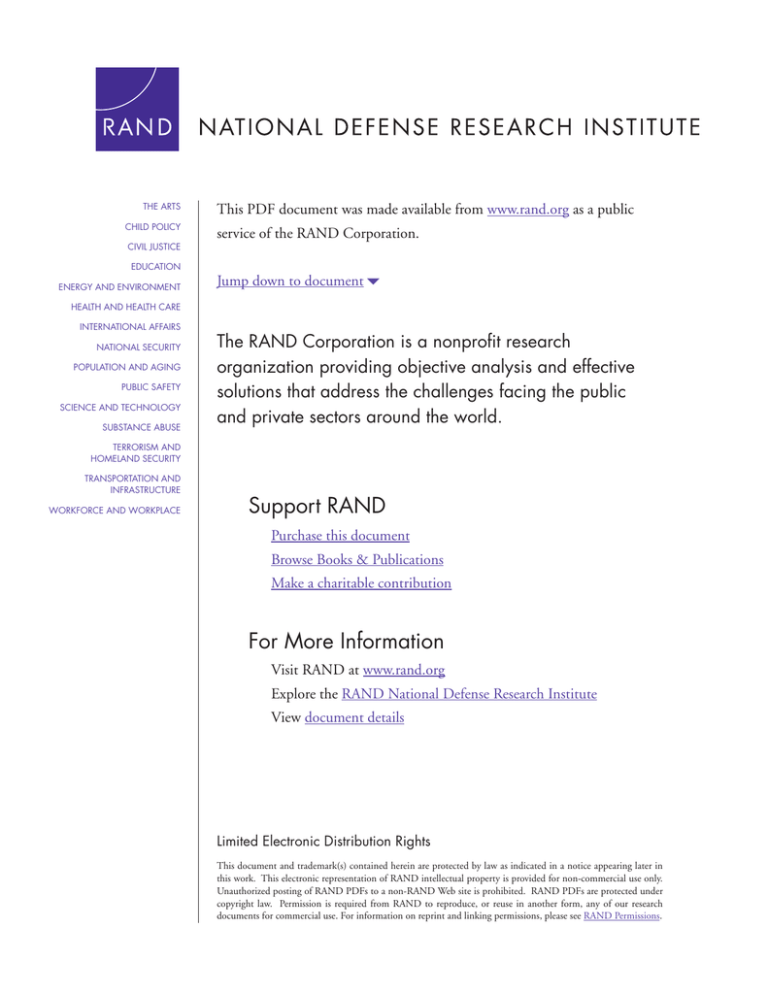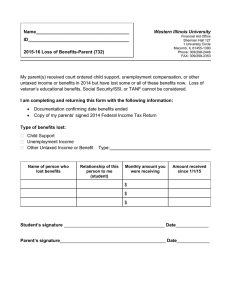
THE ARTS
CHILD POLICY
CIVIL JUSTICE
EDUCATION
ENERGY AND ENVIRONMENT
This PDF document was made available from www.rand.org as a public
service of the RAND Corporation.
Jump down to document6
HEALTH AND HEALTH CARE
INTERNATIONAL AFFAIRS
NATIONAL SECURITY
POPULATION AND AGING
PUBLIC SAFETY
SCIENCE AND TECHNOLOGY
SUBSTANCE ABUSE
The RAND Corporation is a nonprofit research
organization providing objective analysis and effective
solutions that address the challenges facing the public
and private sectors around the world.
TERRORISM AND
HOMELAND SECURITY
TRANSPORTATION AND
INFRASTRUCTURE
WORKFORCE AND WORKPLACE
Support RAND
Purchase this document
Browse Books & Publications
Make a charitable contribution
For More Information
Visit RAND at www.rand.org
Explore the RAND National Defense Research Institute
View document details
Limited Electronic Distribution Rights
This document and trademark(s) contained herein are protected by law as indicated in a notice appearing later in
this work. This electronic representation of RAND intellectual property is provided for non-commercial use only.
Unauthorized posting of RAND PDFs to a non-RAND Web site is prohibited. RAND PDFs are protected under
copyright law. Permission is required from RAND to reproduce, or reuse in another form, any of our research
documents for commercial use. For information on reprint and linking permissions, please see RAND Permissions.
This product is part of the RAND Corporation technical report series. Reports may
include research findings on a specific topic that is limited in scope; present discussions of the methodology employed in research; provide literature reviews, survey
instruments, modeling exercises, guidelines for practitioners and research professionals, and supporting documentation; or deliver preliminary findings. All RAND
reports undergo rigorous peer review to ensure that they meet high standards for research quality and objectivity.
Recent Trends in
Veteran Unemployment
as Measured in the
Current Population Survey
and the American
Community Survey
Bogdan Savych, Jacob Alex Klerman,
David S. Loughran
Prepared for the Office of the Secretary of Defense
Approved for public release; distribution unlimited
NATIONAL DEFENSE RESEARCH INSTITUTE
The research was sponsored by the Off ice of the Secretar y of Defense and
conducted within the Forces and Resources Policy Center of the R AND National
Defense Research Institute (NDRI), a federally funded research and development
center sponsored by the Office of the Secretary of Defense, the Joint Staff, the
Unified Combatant Commands, the Department of the Navy, the Marine Corps,
the defense agencies, and the defense Intelligence Community under Contract
W74V8H-06-C-0002.
Library of Congress Cataloging-in-Publication Data is available for this publication.
ISBN 978-0-8330-4295-8
The RAND Corporation is a nonprofit research organization providing objective analysis
and effective solutions that address the challenges facing the public and private sectors
around the world. RAND’s publications do not necessarily reflect the opinions of its
research clients and sponsors.
R® is a registered trademark.
© Copyright 2008 RAND Corporation
All rights reserved. No part of this book may be reproduced in any form by any electronic or
mechanical means (including photocopying, recording, or information storage and retrieval)
without permission in writing from RAND.
Published 2008 by the RAND Corporation
1776 Main Street, P.O. Box 2138, Santa Monica, CA 90407-2138
1200 South Hayes Street, Arlington, VA 22202-5050
4570 Fifth Avenue, Suite 600, Pittsburgh, PA 15213-2665
RAND URL: http://www.rand.org
To order RAND documents or to obtain additional information, contact
Distribution Services: Telephone: (310) 451-7002;
Fax: (310) 451-6915; Email: order@rand.org
Summary
Official Bureau of Labor Statistics tabulations from the CPS show that the unemployment rate
of young veterans ages 20–24 increased from 11.0 percent in 2003 to 15.6 percent in 2005. The
increase in unemployment among veteran youth was particularly worrisome to policymakers
since, between those same years, the overall youth unemployment rate declined (see Figure
S.1). In 2006, however, official statistics show that the unemployment rate of veteran youth
returned to a level more consistent with long-run historic norms (10.4 percent in 2006).
Figure S.1
Youth Unemployment Rate, by Veteran Status
Unemployment rate
15
10
5
Young veteran
Young nonveteran
0
1994
1995
1996
1997
1998
1999
2000
2001
2002
Year
SOURCE: Authors’ computations based on 1994–2006 monthly CPS data.
NOTE: Sample restricted to youth ages 20–24 in the labor force.
RAND TR485-S.1
xi
2003
2004
2005
2006
xii
Recent Trends in Veteran Unemployment as Measured in the CPS and the ACS
This increase in veteran youth unemployment between 2003 and 2005 is worrisome since
it raises the possibility that young veterans are having difficulty transitioning to civilian jobs
following deployment to Iraq or Afghanistan. On the other hand, the decrease in veteran
youth unemployment between 2005 and 2006 is seen by some as a sign that veteran transition
programs are helping veterans successfully transition to the civilian labor market.
While these are reasonable hypotheses, there is also an alternative explanation. In this
report, we explore whether the increase in unemployment among veteran youth between 2003
and 2005, and then its decrease in 2006, can be attributed to sampling variation alone. We do
this by computing unemployment rates in the CPS and in the much larger ACS and formally
testing whether the variation in veteran and nonveteran unemployment rates is statistically
significant.
Veteran Unemployment in the CPS
The CPS’s sample size of approximately 50,000 households makes it among the largest regular
surveys in the world. However, young veterans are relatively rare in the overall population. On
average, about 115 young veterans take part in each monthly CPS, about 96 of whom are in the
labor force. The small number of young veterans surveyed in the CPS means that unemployment statistics for that group are likely to vary considerably from month to month because of
sampling variability (i.e., which dwelling units happen to be selected for the sample) alone.
Figure S.1 illustrates that between 2003 and 2005, the unemployment rate of young veterans included in the CPS increased by 4.6 percentage points, whereas the unemployment rate
of nonveteran youth decreased by 1.9 percentage points. However, between 2005 and 2006,
the veteran youth unemployment rate decreased by 5.2 percentage points, whereas the nonveteran youth unemployment rate decreased by only 0.6 percentage points. Thus, the gap between
veteran and nonveteran unemployment rates increased sharply between 2003 and 2005 and
then decreased sharply between 2005 and 2006.
Are the wide swings in the unemployment rate of veteran youth indicated by the CPS real
or simply the result of sampling variation? To investigate the possibility that sampling variation
is the cause of these swings in veteran youth unemployment, we computed standard errors on
the annual point estimates of the veteran and nonveteran youth unemployment rates, accounting for the CPS’s sampling design and the fact that CPS respondents are surveyed multiple
times per year.
We then formally tested two hypotheses. The first hypothesis is that the changes in unemployment rates between 2003 and 2005 of veteran and nonveteran youth are equivalent:
V
V ⎤ ⎡ NV
NV ⎤
− U 03
− U
− U 03
=0
H1 : Δ1 = ⎡U 05
⎣
⎦ ⎣ 05
⎦
where U tV is the unemployment rate of veteran youth in year t and U tNV is the unemployment
rate of nonveteran youth in year t. Thus, Δ1 is the difference between the change in veteran
youth unemployment between 2003 and 2005 and the change in nonveteran youth unemployment between 2003 and 2005, which is 4.8 percentage points. We estimate a standard error of
Summary
xiii
2.4 percentage points on Δ1.1 Thus, Δ1 is statistically significant at the 95-percent confidence
level, and so we can reject the hypothesis that the changes in unemployment rates between
2003 and 2005 of veterans and nonveteran youth are equivalent.
The second hypothesis is that the changes in unemployment rates between 2005 and
2006 of veteran and nonveteran youth are equivalent:
V
V ⎤ ⎡ NV
NV ⎤
− U 05
− U
− U 05
=0
H2 : Δ2 = ⎡U 06
⎣
⎦ ⎣ 06
⎦
So, Δ2 is the difference between the change in veteran youth unemployment between 2006
and 2005 and the change in nonveteran youth unemployment between 2006 and 2005, which
is –4.5 percentage points. We estimate a standard error of 2.3 percentage points on Δ2.2 The
p-value for Δ2 is 0.052, which means that Δ2 is on the margin of statistical significance at the
95-percent confidence level.
To summarize, while estimated changes in the veteran youth unemployment rate between
2003 and 2006 are large, so are the standard errors associated with those estimates. Nonetheless, the CPS data show that veteran youth unemployment increased by more than nonveteran
youth unemployment between 2003 and 2005 and that this relative increase is statistically
significant at the 95-percent confidence level. The relative decline in veteran youth unemployment between 2005 and 2006 is statistically significant at the 94-percent confidence level.
We note, however, that we most likely underestimate standard errors in both cases since we
have insufficient information to fully account for the sampling structure of the CPS. If these
standard errors are in fact underestimated, then it is likely that we would fail to reject either
hypothesis at the 95-percent confidence level and perhaps even at the 90-percent confidence
level.
Veteran Unemployment in the ACS
The ACS contains a much larger sample of veteran youth than does the CPS. In 2005, the ACS
contained more than 2,300 young veterans. Furthermore, unlike the CPS, the ACS interviews
a new sample each month; the fact that these 2,300 observations are independent from one
another improves our ability to make inferences from this sample relative to the CPS sample.
Figure S.2 plots annual unemployment rates for veteran and nonveteran youth between
2000 and 2005 in the CPS and ACS. The time-series in unemployment for nonveteran youth
in the ACS is similar to what we observe in the CPS, but the time-series in unemployment
for veteran youth is somewhat different. In particular, while veteran youth unemployment
increases between 2003 and 2004, as in the CPS, it falls back to its 2003 level in 2005.
1
We computed the difference and its standard errors using the “lincom” command in Stata. The standard errors take
into account the structure of the CPS as described in the text above. The 95-percent confidence interval for Δ1 is (0.2, 9.4)
percentage points.
2
The 95-percent confidence interval on Δ 2 is (–8.9, 0.04) percentage points.
xiv
Recent Trends in Veteran Unemployment as Measured in the CPS and the ACS
Figure S.2
CPS and ACS Unemployment Rate, by Veteran Status and Year: Youth Age 20–24
Unemployment rate
15
10
Nonveteran, CPS
Nonveteran, ACS
5
2000
2001
2002
2003
Veteran, CPS
Veteran, ACS
2004
2005
2006
Year
SOURCE: Authors’ computations based on 1994–2006 monthly CPS data and 2000–2005 PUMS ACS.
RAND TR485-S.2
As we did with the CPS, using ACS data, we tested whether the unemployment rate of
veteran youth trends differently than the unemployment rate of nonveteran youth. To test this
hypothesis, we computed the following differences and estimated their standard errors:
V
V ⎤ ⎡ NV
NV ⎤
V
V ⎤ ⎡ NV
NV ⎤
− U 03
and Δ2 = ⎡U 05
− U 03
Δ1 = ⎡U 04
− U
− U 03
− U
− U 03
⎣
⎦ ⎣ 04
⎣
⎦ ⎣ 05
⎦
⎦
We estimate Δ1 to be 2.5 percentage points with a standard error of 1.7 and Δ2 to be 1.4 percentage points with a standard error of 1.7.3 Neither difference is statistically significant at the
95-percent confidence level. Thus, we conclude that, unlike in the CPS, the ACS provides no
evidence that unemployment of veteran youth increased relative to nonveteran youth between
2003 and 2005.
3
The 95-percent confidence interval on Δ1 is (–1.4,6.4), and the confidence interval on Δ 2 is (–1.9, 4.7).
Summary
xv
Discussion
Our analysis of CPS data, the official source for unemployment statistics in the United States,
indicates that veteran youth unemployment increased relative to nonveteran youth unemployment between 2003 and 2005 and that this relative increase is statistically significant. The CPS
data also show that veteran youth unemployment decreased between 2005 and 2006.
The seesaw pattern in veteran unemployment between 2003 and 2006 is difficult to understand in light of current events. It seems possible that veteran youth unemployment could have
increased between 2003 and 2005 as large numbers of active-component and reserve personnel
returned to the civilian labor market following lengthy deployments to Iraq or Afghanistan.
But why would veteran youth unemployment then fall between 2005 and 2006? It is difficult
to believe that economic conditions in general could have such widely differing impacts on the
civilian labor market outcomes of veterans and nonveterans. It also seems unlikely that the
availability of transition-assistance programs for veterans could account for this large relative
decline in unemployment.
In order to argue that the decline in veteran youth unemployment between 2005 and
2006 was attributable to transition-assistance programs offered by the U.S. Department of
Defense, the U.S. Department of Labor, and the U.S. Department of Veteran Affairs, one
would need to argue both that these programs have a large positive effect on military-civilian
transitions in general and that they were substantially more effective in late 2005 and early
2006 than they had been in the previous three years. On the first issue, evidence from random
assignment studies suggests that the effects of employment-assistance programs in general are
likely to be small.4 On the second issue, we are unaware of any major changes in these transition programs that would lead to substantially larger program effects in 2006 than in previous
years.5
Our analysis of ACS unemployment data also draws into question whether veteran youth
unemployment, in fact, increased relative to nonveteran youth unemployment between 2003
and 2005. While veteran youth unemployment did increase in the ACS data between 2003
and 2004, it fell between 2004 and 2005, and none of those changes in unemployment rates
relative to changes in nonveteran youth unemployment rates is statistically significant.
4
5
See, for example, Greenberg et al. (2005, 2001).
Strengthening the argument that the drop in veteran youth unemployment is unlikely to be due to transition-assistance
programs, young veterans sampled by the CPS in 2006 could have separated in any number of years before that date. Consequently, veterans in this sample would have received their transition assistance in a number of different years and so we
would expect even major improvements in transition programs to have only modest effects on unemployment in this overall
sample of veterans.




